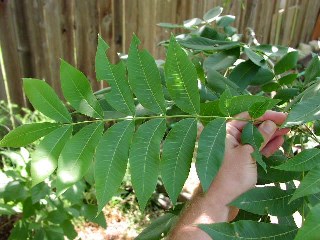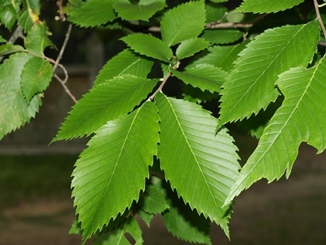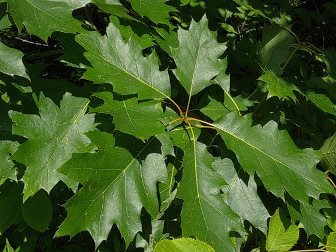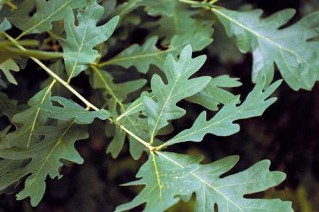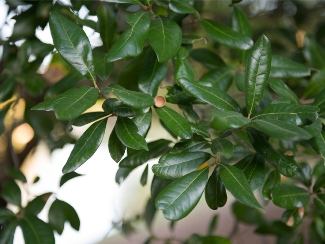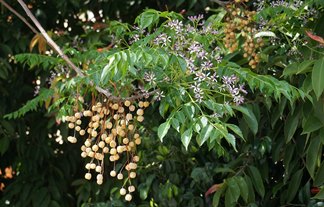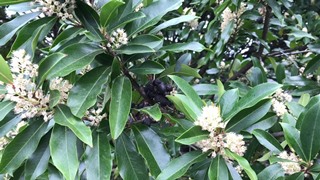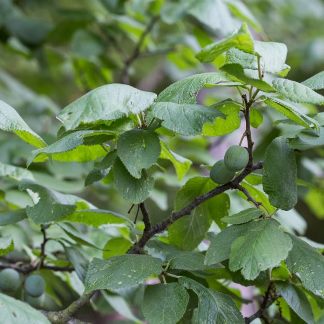|
|
Pecan: Pecan leaves are “pinnate” and composed of around a dozen or more leaflets. Overall the leaf may be 12 to 18 inches long while each leaflet will be sickle-shaped (hooked), 4-7 inches long and 1-3 inches wide. The leaflets are alternate (opposite one another on each side of the center stem) in arrangement. The leaf, composed of these leaflets, is pinnate or feather-like in appearance. Also of note is the edges of the leaflets. They are jagged or toothed around their edges.
American Elm: The leaves of American elm have serrated edges, a distinct pointy tip, and an uneven (oblique) base. One side of the leaf base is always longer than the other. Also, feel the upper surface of the leaf. Most elm leaves have a rough surface that feels like sandpaper.
Hackberry: The leaves of Common hackberry are glossy green, ovate-lanceolate, acuminate and the base is rounded and asymmetric. They are 6 - 10 cm (2.5 – 3.9 in) long and 2,5 – 5 cm (1 – 2 in) broad. The leaf margin is serrated. ... The flower is greenish and comes shortly after the leaf shoots.
Red Oak: Red oak leaves are simple and arranged alternately on the twig. ... They are 7 to 11 lobed, and 5 to 9 inches long with slender petioles 1 to 2 inches long. The lobes are usually no longer than one third the total leaf width; the sinuses of the lobes are u-shaped and the tips of the lobes are bristle tipped.
White Oak:White oak leaves are simple and arranged alternately on twigs. They are 7 to 9 lobed, 5 to 9 inches long with short petioles. The lobes are rounded without bristle tips and vary in length from leaf to leaf but are rather uniform on the same leaf. Surface color is dull green and paler below.
Live Oak: Quercus virginiana leaves stay green year round. It is a semi-deciduous evergreen tree. Depending on the live oak tree age the leaves are normally from 2" to 4" long . Their leaves are very simple and may stay on the tree throughout the winter until new leaves grow in the spring. The leaves are usually narrow to a long oval and are stiff. The upper leaf is shiny and dark green and the underside is normally a light green. Leaves are slightly rolled on the underside.
Chinaberry (Melia azedarach): The leaves are alternate and compound and usually bipinnately but sometimes tripinnately with lengths of 1-2 feet land width of 9-16 inches. The leaves emit a musky odor when crushed. The leaflets are lance shaped and taper towards the tip with a dark green upper surface a lighter green under surface.
Cherry Laurel (Prunus caroliniana): Leaves are firm, smooth, evergreen, narrowly elliptic, tapered to a pointed tip and equally tapered to the base. Margins are smooth on reproductive trees, with narrow, pointed teeth on saplings and root sprouts. Upper surface is dark green and shiny, the lower surface lighter and duller.
Mexican Plum (Prunus Mexicana): a single-trunked, non-suckering tree, 15-35 ft. tall, with fragrant, showy, white flowers displayed before the leaves appear. ... Leaves up to 5 inches long and 2 inches wide, ovate to narrower with serrate margins; minute glands on the petiole near the base of the blade.
Click on author's byline for bio and list of other works published by Pencil Stubs Online.
|



